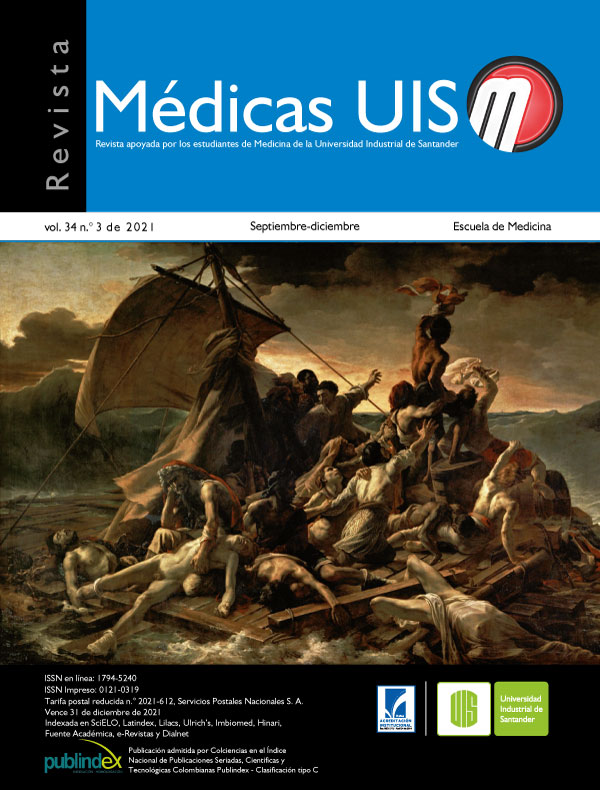Abstract
Sedimentation rate is an indirect inflammation measure, it rises when increase proteins (acute phase reactants) during inflammatory disorders, extreme high value (≥100mm / hour) has a high specificity for the diagnosis of infectious, neoplastic, and autoimmune diseases. Objective: To characterize inpatients with an extreme elevation of the sedimentation rate, and to establish the correlation between determinant factors and extreme sedimentation. Methods: Observational and cross-sectional study, including patients older than 18 years, with an extremely sedimentation rate, hospitalized in Hospital Pablo Tobon Uribe in Medellin city, during November of 2016 to June of 2018. Results: We selected 1007 patients from the data base, Infections were the most common diagnosis (743, 73.8%), and the main type were urinary tract infections (133, 13%). We evidence a negative correlation with the hemoglobin -0.092(-0.155 a -0.029) and with the hematocrit -0.087(-0.150 a -0.024), and a positive and weak significant correlation with the C-reactive protein 0.080 (0.014 a 0.146) p 0.02. Discussion: The infections, as in other studies, represent the main etiology associated with an extreme sedimentation. Different to other analyzed investigations, we observed a direct, weak and statistically significant correlation between the PCR and the extreme VSG. Conclusions: Infections were the main cause of extreme sedimentation rate. We evidence an inverse correlation between the blood sedimentation and the hemoglobin and the hematocrit, and a weak correlation with the C-reactive protein. MÉD.UIS.2021;34(3): 39-45.
References
Gabay C, Kushner I. Acute-Phase Proteins and Other Systemic Responses to Inflammation. N Engl J Med [Internet]. 1999; 340(6): 448-54. Corrección en: N Engl J Med 1999; 340(17): 1376. PubMed PMID: 9971870.
Merino J. Utilidad Diagnóstica de la Velocidad de Sedimentación Globular. Med Integral [Internet]. 2002; 39(7): 325-9. Disponible en: https://www.elsevier.es/es-revista-medicina-integral-63-articulo-utilidad-diagnostica-velocidad-sedimentacionglobular-13029997.
Calderon A, Wener M. Erythrocyte Sedimentation Rate and C-Reactive Protein. Hosp Med Clin [Internet].2012; 1(3): 313-37. DOI: https://doi.org/10.1016/j.ehmc.2012.02.002.
Bathon J, Graves J, Jens P, Hamrick R, Mayes M. The erythrocyte sedimentation rate in end-stage renal failure. Am J Kidney Dis [Internet]. 1987; 10(1): 34-40. DOI: https://doi.org/10.1016/s0272-6386(87)80008-2.
Hayes G, Stinson I. Erythrocyte Sedimentation Rate and Age. Arch Ophthalmol [Internet]. 1976; 94(6): 939-40. DOI: https://doi.org/10.1001/archopht.1976.03910030473007.
Hale A, Ricotta D, Freed J. Evaluating the Erythrocyte Sedimentation Rate. JAMA [Internet]. 2019; 321(14). DOI: https://doi.org/10.1001/jama.2019.1178.
Tishkowski K, Gupta V. Erythrocyte Sedimentation Rate. En: StatPearls [Internet]. Treasure Island (FL): StatPearls. NCBI;2021. Disponible en: https://www.ncbi.nlm.nih.gov/books/NBK557485/.
Otero-Castro V, Bonella B, Cristaldo N, Fiorentini F, Giunta D, Massimino B, et al. Eritrosedimentación extremadamente elevada en una población de adultos en la ciudad de Buenos Aires. Rev Chilena Infectol. 2017; 34(4): 314-18.
Daniels LM, Tosh PK, Fiala JA, Schleck CD, Mandrekar JN, Beckman TJ. Extremely Elevated Erythrocyte Sedimentation Rates: Associations With Patients’ Diagnoses, Demographic Characteristics, and Comorbidities. Mayo Clin Proc. 2017; 92(11): 1636-43.
Brigden ML. Clinical utility of the erythrocyte sedimentation rate. Am Fam Physician. 1999; 60(5): 1443-50.
Alifax. Fully Automated Analyzer for the determination of the ESR [Internet]. Italia: [Citado 11 de junio de 2019]. Disponible en: https://www.alifax.com/products/esr-line/show/test-1.
Johnston KM, Lakzadeh P, Donato BMK, Szabo SM. Methods of sample size calculation in descriptive retrospective burden of illness studies. BMC Med Res Methodol. 2019; 9(1): 1-7.
Charlson ME, Pompei P, Ales KL, MacKenzie CR. A new method of classyfing prognostic comorbidity in longitudinal studies: development and validation. J Chron Dis. 1987; 40(5): 373-83.
MDCALC. Charlson Comorbidity Index (CCI) [Internet]. New York: MDCALC [Citado 16 de octubre de 2019]. Disponible en: https://www.mdcalc.com/charlson-comorbidity-index-cci.
World Medical Association. World Medical Association Declaration of Helsinki Ethical Principles for Medical Research Involving Human Subjects. JAMA. 2013; 310(20): 2191-4.
Severini JM, Miljevic JN. Elevaciones extremas de la velocidad de eritrosedimentación en pacientes internados en un hospital de mediana complejidad de la ciudad de rosario. Rev Méd Rosario. 2013; 79(1): 8-17.
Yousuf M, Akhter J, Al-Khairy K, Al-Saadan MA, Bin-Salih S. Extremely elevated erythrocyte sedimentation rate: etiology at a tertiary care center in Saudi Arabia. Saudi Med J. 2010; 31(11): 1227-31.
Levay PF, Retief JH. Causes of high erythrocyte sedimentation rates in an inpatient population. S Afr Med J. 2005; 95(1): 45-6.
Mora-Rojas RB, Alzate-Posada ML, Rubiano-Mesa YL. Prevention of human immunodeficiency virus (HIV) infection in Colombia: gaps and realities. Rev Gerenc Polít Salud. 2017; 16(33): 19-34.
Ministerio de Salud y Protección Social [Internet]. Bogotá: Colombia se acerca a la meta de diagnóstico en VIH. 2018 [citada 16 de octubre de 2019]. Disponible en: https://www.minsalud.gov.co/Paginas/Colombia-se-acerca-a-la-meta-de-diagnosticoen-VIH.aspx.
Díaz MH, Barrero L, Villalobos A, Ovalle MV. Resistencia bacteriana a los antimicrobianos en el ámbito hospitalario: protocolo de vigilancia en salud pública. Ministerio de Salud y Protección Social. [Internet] 2015 [citada 16 de octubre de 2019]. Disponible en: https://www.ins.gov.co/buscador-eventos/Lineamientos/PRO_Resistencia_bacteriana.pdf.
Cankurtaran M, Ulger Z, Halil M, Yavuz BB, Onal IK, Unal S, et al. How to assess high erythrocyte sedimentation rate (ESR) in elderly? Arch Gerontol Geriatr. 2010; 50(3): 323-6.

This work is licensed under a Creative Commons Attribution 4.0 International License.
Copyright (c) 2021 Médicas UIS
